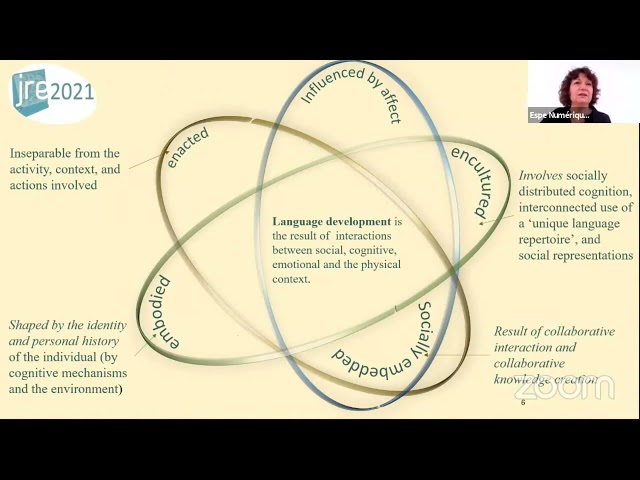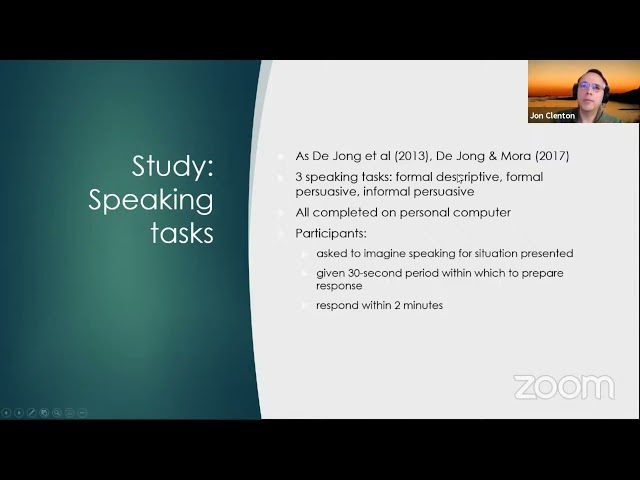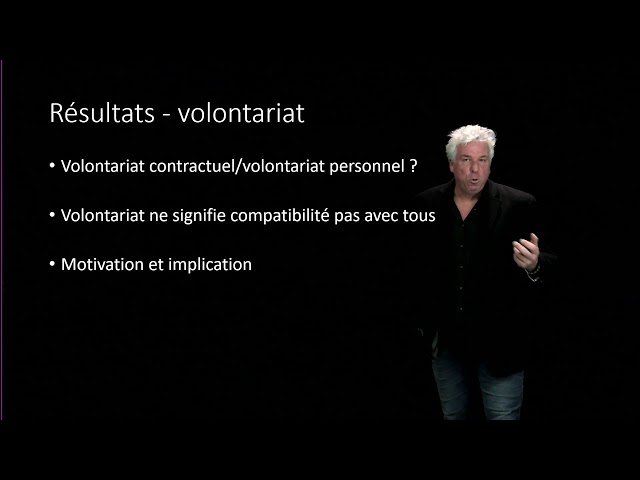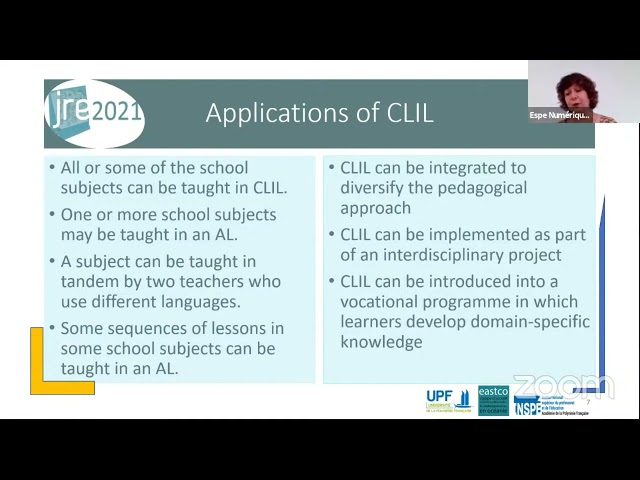Thématique 1
Enseignement d’une Matière par l’Intégration d’une Langue Étrangère (EMILE ; CLIL– Content and Language Integrated Learning en anglais)
Enseignement d’une Matière par l’Intégration d’une Langue Étrangère (EMILE ; CLIL– Content and Language Integrated Learning en anglais)
Voir les conférences
Thématique 2
Apprentissage et enseignement des langues autochtones, secondes et étrangères dans un contexte plurilingue.
Apprentissage et enseignement des langues autochtones, secondes et étrangères dans un contexte plurilingue.
Voir les conférences
Thématique 3
Contextualisations didactiques, approches théoriques et pratiques.
Contextualisations didactiques, approches théoriques et pratiques.
Voir les conférences
Thématique 4
Pédagogies innovantes et nouvelles technologies dans l'enseignement.
Pédagogies innovantes et nouvelles technologies dans l'enseignement.
Voir les conférences
Thématique 5
Pratiques effectives et pratiques déclarées, transmissions à l’école et en famille.
Pratiques effectives et pratiques déclarées, transmissions à l’école et en famille.
Voir les conférences
Filtrer les conférences
In this state-of-the-art paper, we will review the literature on Content and Language Integrated Learning (CLIL) through an analytical lens. It is essential to understand how CLIL has evolved and integrated into the educational literature as a dual-focused educational approach with multiple dimensions and uses. CLIL has been the topic of countless debates since its inception. What is CLIL? Who should teach it? Is CLIL the same as immersion or content-based instruction (CBI)? What are CLIL’s theoretical underpinnings? We consider that an accurate description of the CLIL approach would not be possible without understanding its historicity, political and social context, reasons behind its inauguration, and the theoretical underpinnings that distinguish CLIL from other similar approaches. Relevant literature illustrates that the North American immersion education, which is often a source of confusion and debate among CLIL circles, was used as a point of departure in the inception of CLIL and inspiration during its infancy. However, CLIL has evolved significantly since its inauguration in the 1990s and now it represents an approach that integrates both language and content teaching both in foreign language and bilingual education contexts. EMILE was not created from scratch. Its inception was influenced by a multitude of factors such as (a) historical, political, ideological and societal factors of the 1980s, (b) bilingual language teaching approaches that use second/foreign languages as medium during content teaching, (c) research outcomes on bilingual education, (d) current foreign language approaches and practices, and (e) the alternative theories of learning that drew on the postmodernist philosophies that emerged in the 1980s.
The current paper responds to a research gap in exploring potential relationships between multiple aspects of vocabulary knowledge, vocabulary skills, and aspects of fluency. Studies (e.g., De Jong et al., 2013; Uchihara & Saito, 2016) indicate that vocabulary knowledge is important for fluent speech. At the same time, and in terms of vocabulary knowledge, research (Fitzpatrick & Clenton, 2017) highlights the complexity of constructs, but no studies have concurrently investigated vocabulary knowledge alongside other important factors such as speed and automaticity of retrieval (Qian, 2002). The paper attempts to respond to these various research gaps, in investigating potential relationships between vocabulary, skills (e.g., retrieval speed), and aspects of fluency.30 pre-intermediate, adult L1 Japanese users of (L2) English were measured using: a productive vocabulary task (Lex30; Meara & Fitzpatrick, 2000); a receptive task (X_lex; Meara & Milton, 2003); and the same fluency tasks (speaking and lexical retrieval speed) as in De Jong et al (2013). We explored the overlap between the vocabulary and fluency tasks using Dang, Coxhead, and Webb’s (2017) Academic Spoken Word List. Our findings show that vocabulary knowledge tasks are moderately predictive of some aspects of fluency. We report four additional tentative findings. The study is the first of its kind to relate specific vocabulary skills to fluency at a specific level of L2 proficiency. We discuss such findings in terms of their implications for second language acquisition and testing.
Dans le cadre d’une recherche-action portant sur le développement du coenseignement en contexte EMILE (français/anglais) en enseignement primaire, les configurations et conditions de mise en œuvre du coenseignement à fondement linguistique ont été analysées. S’appuyant sur des observations réalisées en classe ainsi que des entretiens d’autoconfrontation avec les coenseignants, l’objectif de cette communication est d’identifier, de requestionner et de préciser les configurations et les conditions du coenseignement avec, non pas un enseignant spécialisé, mais avec un enseignant spécialiste en langue sur la base d’une comparaison entre binômes (interbinôme et intrabinôme). Les résultats permettent de préciser certaines conditions en sous-conditions. Ceux-ci montrent que la formation initiale (pédagogique) des enseignants spécialistes en langue est une condition essentielle. Par ailleurs, la dispersion du coenseignement, lié à l’organisation scolaire (ex. : organisation des horaires), amène des défis supplémentaires en ce qui concerne la coplanification des activités communes en classe. De plus, en ce qui concerne les configurations possibles en contexte de coenseignement linguistique, celles-ci apparaissent plus limitées qu’avec un autre enseignant à cause de la double contrainte liée d’une part au programme de la matière enseignée et d’autre part, en regard des compétences linguistiques que l’on souhaite développer.
Les albums de Chris Haughton constituent des supports de choix pour l’enseignement/apprentissage de l’anglais à l’école primaire en France mais sont, avant tout, des textes littéraires permettant aux élèves de construire des compétences de lecteurs et d’articuler leurs apprentissages en L1 et L2 (Deyrich, 2011), particulièrement dans la réalisation de tâches finales comme par exemple, la mise en scène de l’histoire Shh, We Have a Plan! en anglais, langue intégrée à la découverte d’une œuvre littéraire et à un travail en EPS, dans la logique de l’EMILE. Ajoutant des données scientifiques à son récit Good Night, Everyone!, Chris Haughton a aussi établi une relation entre récit de fiction et sciences, déjà étudiée par Bruguière et Triquet (2010 et 2012). Il a également travaillé avec des scientifiques sur un projet de film d’animation, Message from Antartica, support de choix pour construire une séance d’EMILE en sciences. Enfin, cet auteur s’est aussi lancé dans la création d’un album interactif sous la forme d’un jeu de réalité virtuelle, Little Earth, pour offrir une découverte de notre environnement et de notre planète à laquelle son lecteur participe pleinement. Cette communication se propose de présenter tout d’abord les albums de Chris Haughton et leur évolution et surtout de montrer qu’à l’école primaire, ces œuvres se prêtent parfaitement à la réalisation de projets interdisciplinaires et peuvent déboucher sur la mise en place de séances d’EMILE facilitant l’appropriation de savoirs scientifiques grâce à la découverte d’un texte de fiction en version originale.
This presentation describes a framework that we developed through a series of studies on Content and Language Integrated Learning (CLIL) that we conducted from 2011 to the present in the French Polynesian elementary school context. We have tested and developed this framework through experimentation using iterative microgenetic interaction analysis techniques. We have called this framework “socially mediated activity” (SMA) framework. This framework is based on a set of principles conveyed through sociocultural theories of learning, the socio-interactionist perspective and competency-based additional language (AL) pedagogies (e.g., CLIL, task-based language instruction, action-oriented approach). This framework is based on the observations that (i) language is a tool for learning and that language skills cannot be fully developed without active participation and reflection, (ii) learning occurs in the learners’ ZPD where help is given during collaborative activity, (iii) learning is observable during a joint activity in which mediational tools and joint actions are used to perform the activity, and (iv) the creation of a naturalistic learning environment would not be possible without the use of social artefacts and other non-verbal elements that enhances both cognitive and communicative aspects of task outcomes. This framework is suitable for combining content and AL teaching both in mainstream additional language learning and CLIL settings. We tested our model merely with young learners (aged 9-10) and the application of this framework with young learners presented satisfactory results. However, we are confident that this framework can also be operational with CLIL for middle and high school students (e.g., teaching science experiments, geography, arts).






